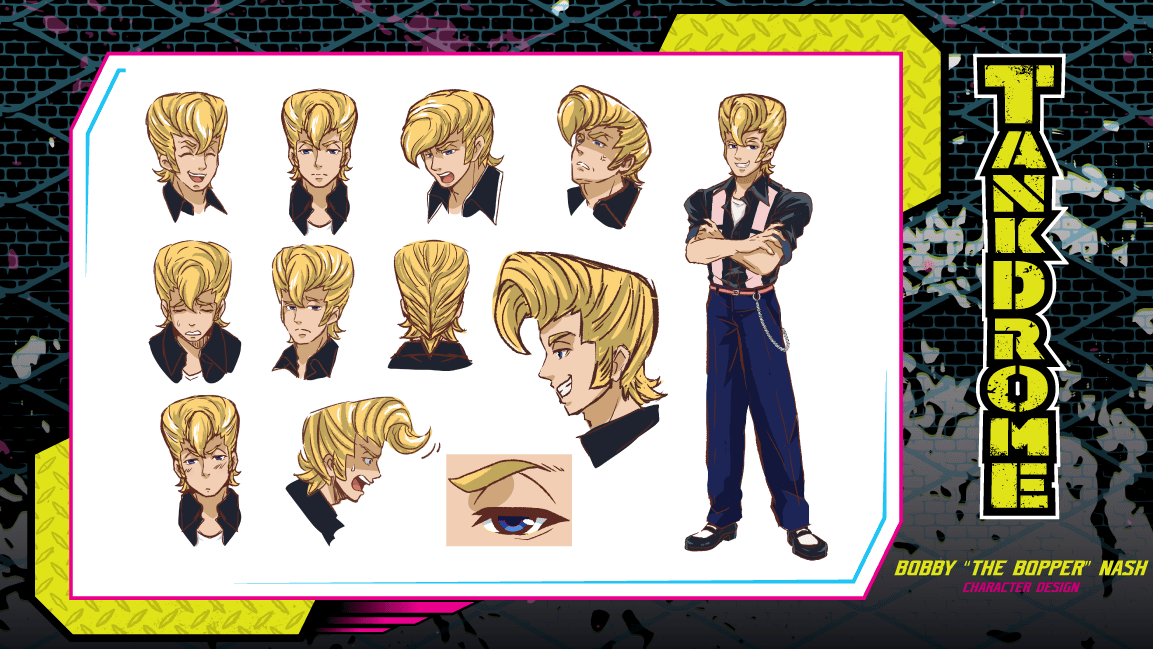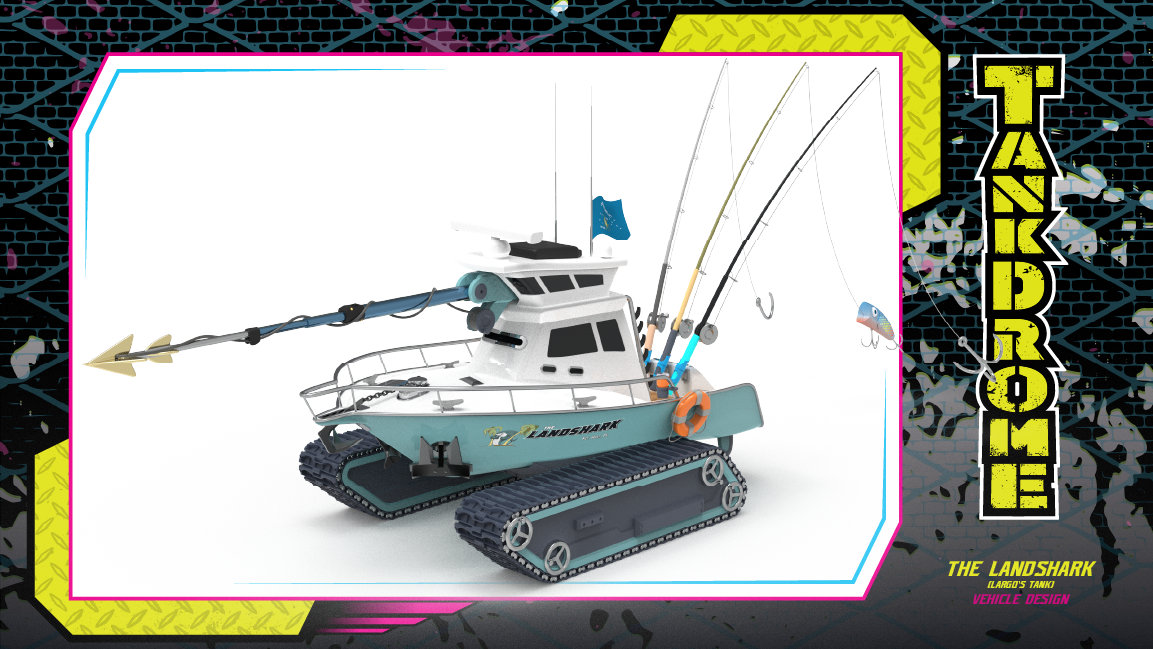
Panda Mony Toy Brands, LLC, which was founded by Ryan Magnon, has teamed up with Studio Entertainment Graphic Innovation (a.k.a. ENGI), a company backed by KADOKAWA, Sammy Corporation, and Ultra Super Pictures, for the graphic novel series Tankdrome. Tankdrome is set to debut in 2024, and with the announcement just made, Magnon spoke to Otaku USA about the collaboration, his background in anime and manga, and what the story will be about.
Otaku USA: How did you first get interested in anime and manga?
Ryan Magnon: As a toy maker, it may come as no surprise that I was introduced to anime and manga through toys and video games.
Voltron toys were innovative and imaginative. I had to see the show and get all the lions (I failed at that latter part). That was the first anime I followed. I didn’t really know the show was originally from Japan. I just appreciated it for what it was without regard for where it came from. I was only maybe 4 years old though. I don’t think I even heard the term “anime” until the 90s. I think at that time, there were even strange, unsophisticated barbarians calling it “Japanimation” before the “anime” side prevailed. There may have been casualties in that battle, I don’t know. We prefer not to talk about that dark time in my household.
I didn’t buy my first manga until the mid 2000s. There was an animated series called Megaman NT Warrior (in Japan it was called Rockman.exe) based on the video game series. I was a huge fan at the time, and was obsessed with seeing more when the show was taken off the air here. Since I was a kid, I was always fascinated by Japanese culture and history, so one day, for fun, I wandered into a store that specialized in Japanese goods at my local mall. Of course it had manga, and I was pleasantly surprised to find three books for the manga adaptation of NT.
Elements from Voltron, Rockman.exe, and especially another Capcom favorite, Street Fighter, can be seen in our new brand, Tankdrome.

What was the process of reaching out to ENGI Co. so you could team up? How do you continue to collaborate?
I’d started by digging into studios producing manga and anime whose work I thought was good. Looking into their websites and other online information about them gave me an idea of who was doing what and what type of partnerships, for lack of a better term, they sought. For example, if their website suggests they weren’t interested in any sort of solicitation or they do work far outside of what I was looking for, it, of course, didn’t make sense to try to overcome that resistance. Second, ENGI was one of the few studios that offered both an English and Japanese website. I found that encouraging; I could reasonably assume they were seeking international business.
Nevertheless, I thought it presumptuous to write to them in English only, and I offered both an English and Japanese introductory email. Panda Mony Toy Brands has a modest, but respectable line of toys in Alter Nation behind it. That may have helped. I’m not sure. I mentioned in my email because I didn’t want to appear as if I was doing this for a lark. I was fortunate to find the company president, Hiroki Yoshioka, was seeking to expand his company’s experience with international productions. My reasonable assumption was right. Since my approach was very careful and my project small, it might’ve been a better fit for ENGI than a full-blown animated series like the ones they are known for.
That was August 2022. Since then, they’ve been doing various art tests and character development while I worked on the brand and my team and I developed the story. To help the two sides communicate, I’ve been utilizing a combination of A.I., translation tools, Japanese dictionaries, and my poor grasp of Japanese to write my emails and notes in both languages. They do something similar on their side too. I utilize a lot of photo reference in our communication as well, but that’s pretty common with any team I work with.
Can you tell us a little about Tankdrome, and how it will blend Eastern and Western art?
Sure. Tankdrome is set in the distant future where, having resolved to end warfare, the nations of the world agreed to settle all geopolitical disputes, as well as some personal disputes, in one-on-one tank battle. Battles are administered by the International Tankdrome League. Our story starts with this Tankdrome system having been in place for decades and its matches regularly being the world’s number one televised event. Different regions have their own champions and, like Street Fighter, these champions’ personalities generally reflect where they’re from; a Memphis rockabilly driver has a ’57 Chevy tank that shoots deadly jukebox records, the Chicago mobster has a 1920s tank with tommy guns for a cannon, there’s a rapper with a lowrider-tank that hops to attack. As I worked on the brand, I had fun finding subcultures tied to specific vehicles. Tankdrome itself is a lot of action-heavy fun, in contrast to the more serious tone of Alter Nation, our previous brand.
We blend Eastern and Western art in a lot of ways. First is that the Japan team is designing all of the character art while we provide all of the vehicle design. Their team takes our toy-ready 3D models and uses them to draw the comic for a more realistic style of drawing.

For some specific American characters, our team offers reference for clothes and hairstyles we’d like to imitate. The Japanese team takes that and puts it into an anime style. With the distinction between the two cultures, a lot of that subculture gets lost in the journey around the globe, so it was a fun opportunity to bring it all together. I would explain to them what an aspect of the story meant, they would tell me more about subcultures of Japan. For example, I learned about “bōsōzoku” motorcycles in Japan. I developed a tank and a character around it, but she’s going to be a hero. Later on, based on what I was reading, I was concerned it would be glamorizing something seen as a negative over there, akin to something like street gangs in the U.S. The Japan team was able to talk to me a little bit more about the trend beyond what Wikipedia might offer and we concluded my concerns were overly sensitive.
Lastly, and this is a bit technical, but one thing I’m really proud of with our first book is that I took care to combine 3-act Hollywood style story structure into 4-act Kishōtenketsu story structure. I hope it’s something we can continue throughout the brand. I suppose I should also mention that the story has an American writing team for its first issue. Different cultures have different senses of humor, and I found myself having to explain jokes quite a bit more than I expected… Which could also imply that the jokes just weren’t funny! Regardless, I hope that an American audience who appreciates anime visuals can appreciate the unique story style we’re offering.
Where can people learn more about the Tankdrome franchise?
Tankdrome and Panda Mony Toy Brands are on Twitter, Facebook, and Instagram, and on the web at PandaMony.toys. Closer to the series launch, we’ll also have the “Tankdrome Pit Pass,” a fan club with mail-away goodies just for kids.
Is there anything else you’re working on that you’d like to share?
Yes, I’m also working on an anthology book of short stories for Alter Nation intended for young readers. The book’s already written, but we’re working on finding the right artist. The theme of the anthology is a collection of paranormal missions, and we want the images in the book to have a “found footage” look, practically indistinguishable from real photos. It should be out 2024 if we find the right match. My hope with it is to follow the path forged by Scary Stories to Tell in the Dark. The anthology style and captivating art of that series really resonated with me as a kid.
____
Danica Davidson is the author of the bestselling Manga Art for Beginners with artist Melanie Westin, plus its sequel, Manga Art for Everyone, and the first-of-its-kind manga chalk book Chalk Art Manga, both illustrated by professional Japanese mangaka Rena Saiya. Check out her other comics and books at www.danicadavidson.com.

